Here’s Our Top 10 Crabs for Your Reef Aquarium!
Welcome to our detailed guide on the top ten crabs you should consider for your reef aquarium. These crustaceans not only add intrigue and beauty to your tank but also play crucial roles in maintaining ecological balance by acting as cleaners. Here’s a deeper look into each of these fascinating species, along with care requirements, diet information, and advice on keeping different types of crabs together.
Read Until the End for Care Requirements & Help Mixing Species…
1. Emerald Crab
(Mithraculus)

- Origin: Caribbean
- Size: Up to 2 inches
- Reef Safe: Yes, with caution
- Diet: Omnivore
Overview:
Emerald Crabs are appreciated for their vibrant green colour and effectiveness at controlling algae, including problematic types like bubble algae.
2. Sally Lightfoot Crab
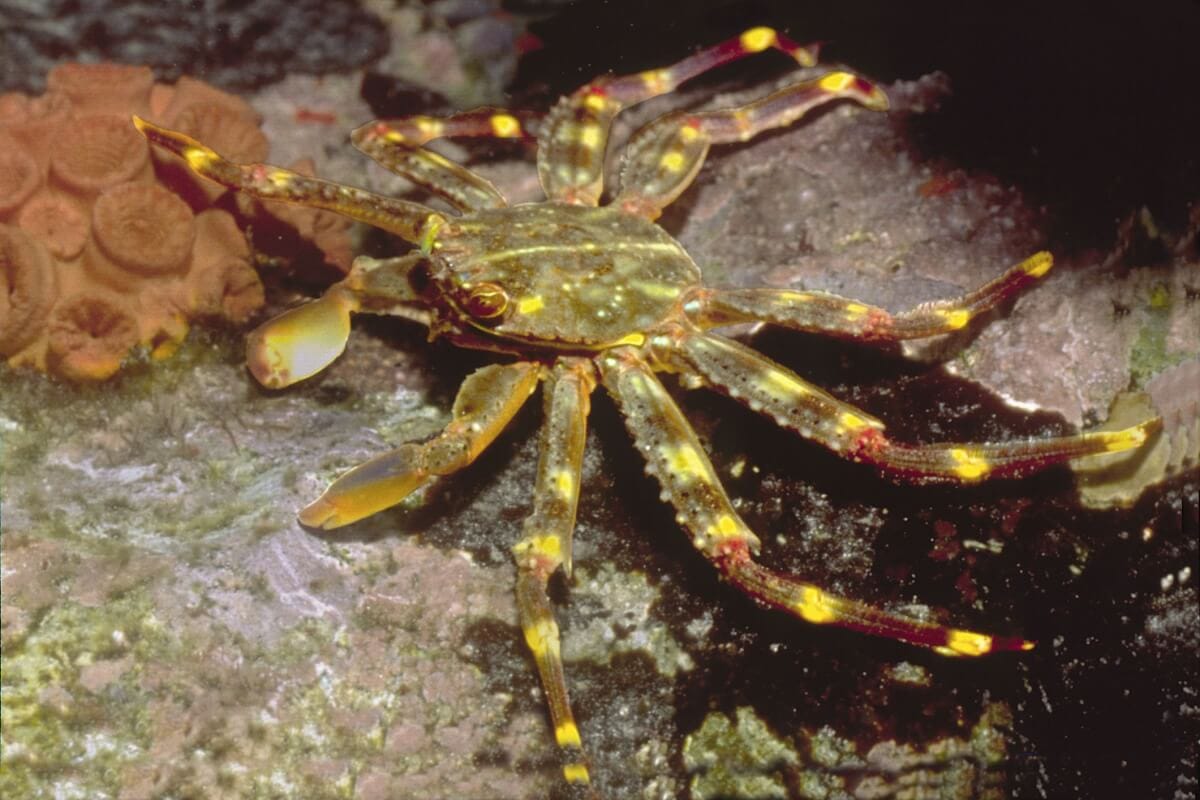
- Origin: Tropical Western Atlantic
- Size: Up to 5 inches
- Reef Safe: With caution
- Diet: Omnivore
Overview:
Known for its striking appearance and agility, the Sally Lightfoot Crab is a robust cleaner, handling uneaten food and pests alike.
3. Porcelain Crab
(Porcellanidae family)
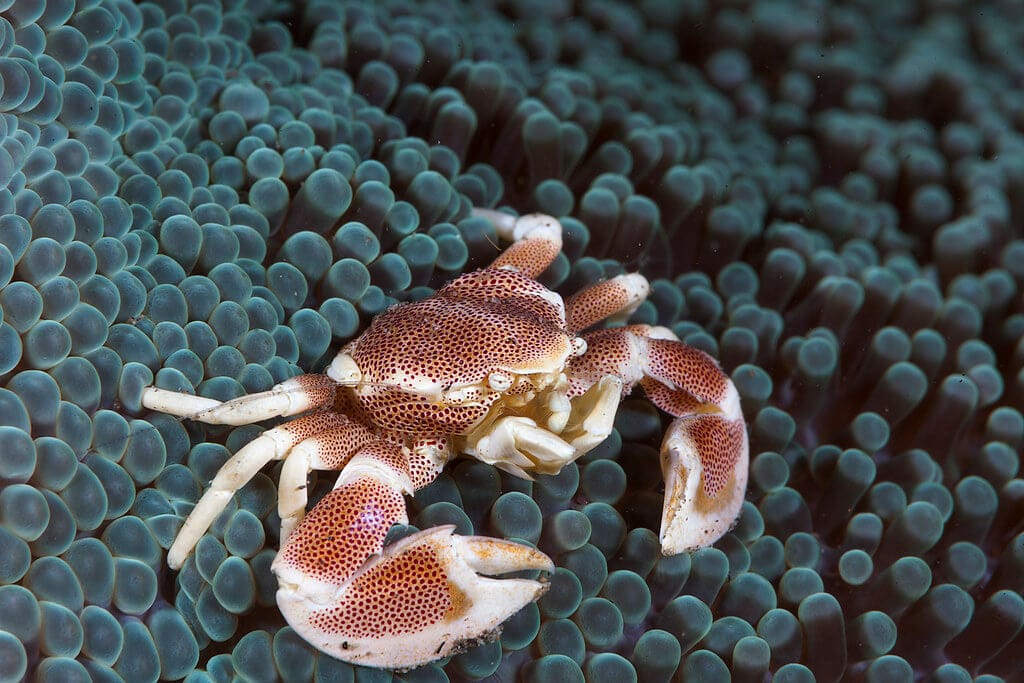
- Origin: Worldwide distribution
- Size: About 1-2 inches
- Reef Safe: Yes
- Diet: Filter feeder
Overview:
Small and peaceful, Porcelain Crabs are excellent for community tanks due to their non-aggressive nature and filtering capabilities.
4. Arrow Crab
(Stenorhynchus seticornis)
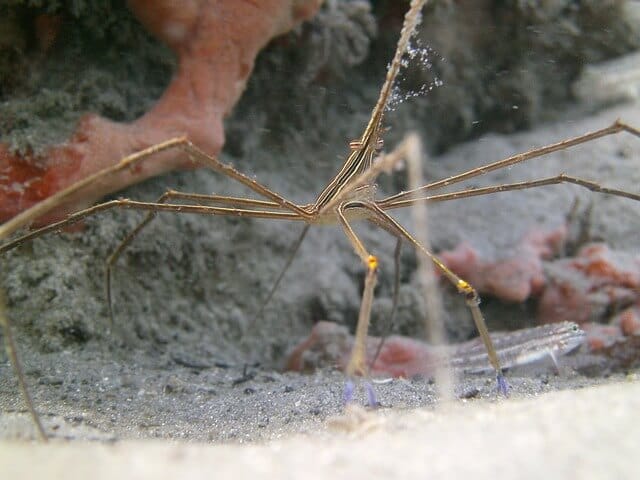
- Origin: Caribbean, Gulf of Mexico
- Size: Up to 6 inches (leg span)
- Reef Safe: Yes, with caution
- Diet: Omnivore
Overview:
Arrow Crabs are distinctive with their long, spider-like legs, great for reaching into crevices to remove detritus and pests.
5. Electric Blue Leg Hermit Crab
(Calcinus elegans)

- Origin: Indo-Pacific
- Size: About 1 inch
- Reef Safe: Yes
- Diet: Omnivore
Overview:
The Electric Blue Leg Hermit Crab stands out with its striking blue legs and is highly effective at controlling algae and cleaning up detritus.
6. Halloween Hermit Crab
(Ciliopagurus strigatus)

- Origin: Central Pacific
- Size: About 2-3 inches
- Reef Safe: Yes
- Diet: Omnivore
Overview:
With its vivid orange and black banding, the Halloween Hermit Crab not only adds a splash of colour but also excels at cleaning algae from the tank.
7. Scarlet Red Leg Hermit Crab
(Paguristes cadenati)

- Origin: Caribbean
- Size: Up to 2 inches
- Reef Safe: Yes
- Diet: Omnivore
Overview:
This small hermit crab is known for its bright red legs and diligent scavenging, making it an effective part of any aquarium’s cleanup crew.
8. Bumblebee Crab
(Trapezia spp.)
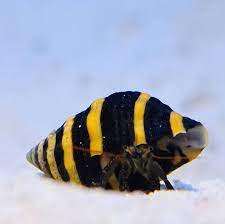
- Origin: Indo-Pacific
- Size: Less than 1 inch
- Reef Safe: Yes
- Diet: Omnivore
Overview:
The Bumblebee Crab, with its distinctive yellow and black striped patterning, is not only a striking addition but also useful for maintaining coral health by protecting them from pests.
9. Antler Crab
(Lambdacarcinus)

- Origin: Western Pacific
- Size: Up to 3 inches
- Reef Safe: Mostly yes
- Diet: Omnivore
Overview:
Named for its unique antler-like rostrum, the Antler Crab is a fascinating spectacle and provides essential cleaning services by eating detritus and algae.
10. Pom Pom Crab
(Lybia tessellata)
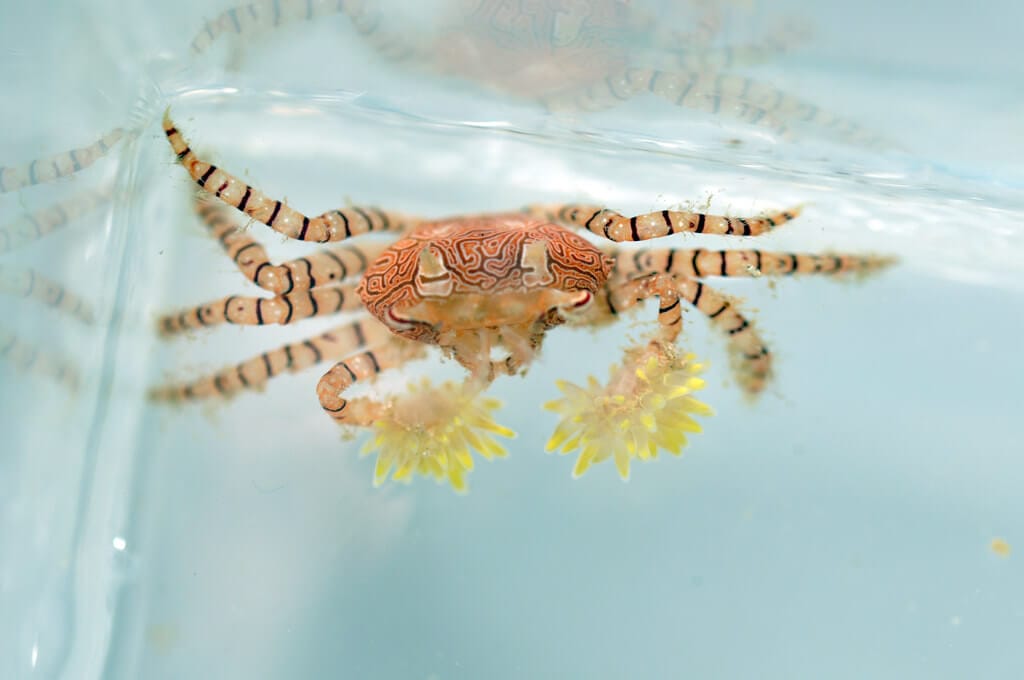
- Origin: Indo-Pacific
- Size: About 1 inch
- Reef Safe: Yes
- Diet: Omnivore
Overview:
Pom Pom Crabs are adorable and small, often seen carrying anemones in their claws for defence. They are peaceful and help maintain tank cleanliness by consuming leftover food and small particles.
Crab Care Requirements
Ideal Parameters:
- Temperature: 72-78°F (22-26°C)
- pH: 8.1-8.4
- Salinity: 1.023-1.025 specific gravity
- Alkalinity: 8-12 dKH
Maintaining stable water conditions is crucial for the health of your crabs. Regular water changes, adequate filtration, and monitoring of water parameters are essential practices. Most crabs need a tank with plenty of hiding places and stable rockwork, as they often retreat to crevices for molting and protection.
Diet and Feeding
Crabs are generally omnivorous and will eat a variety of foods, but specific dietary requirements can vary between species:
- Algae and Detritus: Many crabs, such as the Emerald and Hermit crabs, help in controlling algae levels and consume detritus, supplementing their diet with tank leftovers.
- Specialised Diets: Some crabs like the Porcelain Crab are filter feeders and require fine particulate organic matter suspended in the water.
- Supplemental Feeding: It’s beneficial to supplement their diet with quality marine foods, including sinking pellets, flakes, and occasionally, fresh vegetables or meats depending on the crab species.
Proper feeding ensures that crabs do not turn to preying on tank mates or corals, particularly in cases of underfeeding.
Can I Keep Different Types of Crab in My Reef Together?
Keeping multiple types of crabs in a single tank can be successful if certain conditions are met. Space is a significant factor; a crowded tank can lead to territorial disputes, especially during molting when crabs are most vulnerable. It’s important to:
- Match Sizes and Temperaments: Larger, more aggressive crabs can bully or eat smaller, more docile species.
- Provide Adequate Space and Hiding Spots: This helps reduce competition for territory and resources.
- Monitor Interactions: Especially when introducing new crabs to an established community, observe their interactions closely to ensure no bullying or harm occurs.
Compatibility depends largely on the individual species’ nature and the environment you provide for them. Research each species’ behaviour and requirements thoroughly before mixing in your tank.
Conclusion
Choosing the right crabs for your reef aquarium is crucial for maintaining a healthy and vibrant ecosystem. Each crab species offers unique benefits and challenges, so consider your tank’s specific needs and existing inhabitants when making your selection. Properly cared for, these crabs can become both helpful janitors and fascinating features in your reef setup. Their diverse diets and the inter-species dynamics also play a significant role in the overall health and stability of the aquarium.

